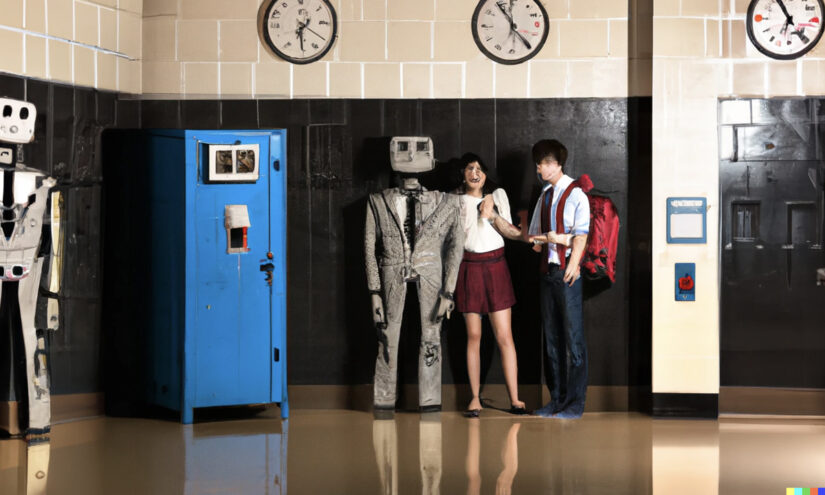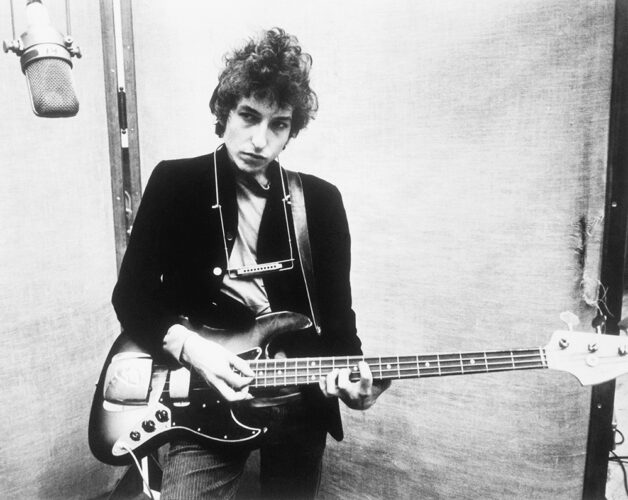The Future of the High School Essay: We Talk to 4 Teachers, 2 Experts and 1 AI Chatbot
ChatGPT, a new, easy-to-use AI tool, could upend the way students learn about writing and self-expression. Is that such a bad thing?
By Greg Toppo | December 19, 2022ChatGPT, an AI-powered “large language” model, is poised to change the way high school English teachers do their jobs. With the ability to understand and respond to natural language, ChatGPT is a valuable tool for educators looking to provide personalized instruction and feedback to their students.
O.K., you’ve probably figured out by now that ChatGPT wrote that self-congratulatory opening. But it raises a question: If AI can produce a journalistic lede on command, what mischief could it unleash in high school English?
Actually, the chatbot, unveiled last month by the San Francisco-based R&D company Open AI, is not intended to make high school English teachers obsolete. Instead, it is designed to assist teachers in their work and help them to provide better instruction and support to their students.
O.K., ChatGPT wrote most of that too. But you see the problem here, right?
English teachers, whose job is to get young students to read and think deeply and write clearly, are this winter coming up against a formidable, free-to-use foe that can do it all: With just a short prompt, it writes essays, poems, business letters, song lyrics, short stories, legal documents, computer code, even outlines and analyses of other writings.
One user asked it to write a letter to her son explaining that “Santa isn’t real and we make up stories out of love.” In five trim paragraphs, it broke the bad news from Santa himself and told the boy, “I want you to know that the love and care that your parents have for you is real. They have created special memories and traditions for you out of love and a desire to make your childhood special.”
One TikToker noted recently that users can upload a podcast, lecture, or YouTube video transcript and ask ChatGPT to take complete notes.
@tech.n.trendz ChatGPT Taking Notes From YouTube #chatgpt #openai #dalle2 #AI #artificialintelligence #gaming #news #fyp ♬ original sound – Riley Brown
Many educators are alarmed. One high school computer science teacher confessed last week, “I am having an existential crisis.” Many of those who have played with the tool over the past few weeks fear it could tempt millions of students to outsource their assignments and basically give up on learning to listen, think, read, or write.
Others, however, see potential in the new tool. Upon ChatGPT’s release, The 74 queried high school teachers and other educators, as well as thinkers in the tech and AI fields, to help us make sense of this development.
Here are seven ideas, only one of which was written by ChatGPT itself:
1. By its own admission, it messes up.
When we asked ChatGPT, “What’s the most important thing teachers need to know about you?” it offered that it’s “not a tool for teaching or providing educational content, and should not be used as a substitute for a teacher or educational resource.” It also admitted that it’s “not perfect and may generate responses that are inappropriate or incorrect. It is important to use ChatGPT with caution and to always fact-check any information it provides.”
2. It’s going to force teachers to rethink their practice — whether they like it or not.
Josh Thompson, a former Virginia high school English teacher working on these issues for the National Council of Teachers of English, said it’s naïve to think that students won’t find ChatGPT very, very soon, and start using it for assignments. “Students have probably already seen that it’s out there,” he said. “So we kind of have to just think, ‘O.K., well, how is this going to affect us?’”

In a word, Thompson said, it’s going to upend conventional wisdom about what’s important in the classroom, putting more emphasis on the writing process than the product. Teachers will need to refocus, perhaps even using ChatGPT to help students draft and revise. Students “might turn in this robotic draft, and then we have a conference about it and we talk,” he said.
The tool will force a painful conversation, Thompson and others said, about the utility of teaching the standard five-paragraph essay, which he joked “should be thrown out the window anyway.” While it’s a good template for developing ideas, it’s really just a starting point. Even now, Thompson tells students to think of each of the paragraphs not as complete writing, but as the starting point for sections of a larger essay that only they can write.
3. It’s going to refocus teachers on helping students find their authentic voice.
In that sense, said Sawsan Jaber, a longtime English teacher at East Leyden High School in Franklin Park, Ill., this may be a positive development. “I really think that a key to education in general is we’re missing authenticity.”
Technology like ChatGPT may force teachers to focus less on standard forms and more on student voice and identity. It may also force students to think more deeply about the audience for their writing, which an AI likely will never be able to do effectively.

“I think education in general just needs a facelift,” she said, one that helps teachers focus more closely on students’ needs. Actually, Jaber said, the benefits of a free tool like ChatGPT might most readily benefit students like hers from low-income households in areas like Franklin Park, near Chicago’s O’Hare Airport. “The world is changing, and instead of fighting it, we have to ask ourselves: ‘Are the skills that we’ve historically taught kids the skills that they still need in order to be successful in the current context? And I’m not sure that they are.”
Jaber noted that universities are asking students to do more project-based and “unconventional” work that requires imagination. “So why are we so stuck on getting kids to write the five-paragraph essay and worrying if they’re using an AI generator or something else to really come up with it?”

4. It could upend more than just classroom practice, calling into question everything from Advanced Placement assignments to college essays.
Shelley Rodrigo, senior director of the Writing Program at the University of Arizona, said the need for writing instruction won’t go away. But what may soon disappear is the “simplistic display of knowledge” schools have valued for decades.

“If it’s, ‘Compare and contrast these two novels,’ O.K., that’s a really generic assignment that AI can pull stuff from the Internet really easily,” she said. But if an assignment asks students to bring their life experience to the discussion of a novel, students can’t rely on AI for help.
“If you don’t want generic answers,” she said, “don’t ask generic questions.”
In looking at coverage of the kinds of writing uploaded from ChatGPT, Rodrigo, also present-elect of NCTE, said it’s easy to see a pattern that others have commented on: Most of it looks like something that would score well on an AP exam. “Part of me is like, ‘O.K., so that potentially is a sign that that system is broken.’”
5. Students: Your teachers may already be able to spot AI-assisted writing.
While one of the advantages of relying on ChatGPT may be that it’s not technically plagiarism or even the product of an essay mill, that doesn’t mean it’s 100% foolproof.

Eric Wang, a statistician and vice president of AI at Turnitin.com, the plagiarism-detection firm, noted that engineers there can already detect writing created by large-language “fill-in-the-next-word” processes, which is what most AI models use.
How? It tends to follow predictable patterns. For one thing, it uses fewer sophisticated words than humans do: “Words that are less frequent, maybe a little more esoteric — like the word ‘esoteric,’” he said. “Our use of rare words is more common.”
AI applications tend to use more high-probability words in expected places and “favor those more probable words,” Wang said. “So we can detect it.”
Kids: Your untraceable essay may in fact be untraceable — but it’s not undetectable.
6. Like most technological breakthroughs, ChatGPT should be understood, not limited or banned — but that takes commitment.
L.M. Sacasas, a writer who publishes The Convivial Society, a newsletter on technology and culture, likened the response to ChatGPT to the early days of Wikipedia: While many teachers saw that research tool as radioactive, a few tried to help students understand “what it did well, what its limitations were, what might be some good ways of using Wikipedia in their research.”
In 2022, most educators — as well as most students — now see that Wikipedia has its place. A well-constructed page not only helps orient a reader; it’s also “kind of a launching pad to other sources,” Sacasas said. “So you know both what it can do for you and what it can’t. And you treat it accordingly.”
Sacasas hopes teachers use the same logic with ChatGPT.
More broadly, he said, teachers must do a better job helping students see how what they’re learning has value. So far, “I think we haven’t done a very good job of that, so that it’s easier for students to just take the shortcut” and ask software to fill in rather meaningless blanks.
If even competent students are simply going through the motions, he said, “that will encourage students to make the worst use of these tools. And so the real project for us, I’m convinced, is just to instill a sense of the value of learning, the value of engaging texts deeply, the value of aesthetic pleasure that cannot be instrumentalized. That’s very hard work.”

7. Underestimate it at your peril.
Open AI’s Sam Altman earlier this month tried to lower expectations, tweeting that the tool “is incredibly limited, but good enough at some things to create a misleading impression of greatness.”

Ask ChatGPT to write a Bob Dylan song about Baltimore, for example, and … well, it’s not very good or very Dylanesque at the moment. The chorus:
Baltimore, Baltimore
My home away from home
The people are friendly
And the crab cakes are to die for.
Altman added, “It’s a mistake to be relying on it for anything important right now.”

The tool’s capabilities in many ways may not be very sophisticated now, said Jake Carr, an English teacher in northern California. “But we’re fooling ourselves if we think something like ChatGPT isn’t only going to get better.”
Carr asked the tool to write a short story about “kids who ride flying narwhals” and got a rudimentary “Golden Books” sort of tale. But then he got an idea: Could it produce an outline of such a story using Joseph Campbell’s “Hero’s Journey” template?
It could and it did, producing “a pretty darn good outline” that used all of the storytelling elements typically present in popular fiction and screenplays.
He also cut-and-pasted several of his students’ essay drafts into the tool and asked it to grade each one based on a rubric he provided.
@mr.carr.on.the.web Revolutionizing the English classroom with AI—how can we use technology to enhance student learning and engagement? 🤖 📚 #englishteacher #edtech #ai #chatgpt ♬ original sound – Mr. Carr On The Web | EduTok
“I tell you what: It’s not bad,” he said. The tool even isolated each essay’s thesis statement.
Carr, who frequently posts TikToks about tech, admitted that ChatGPT is scary for many teachers, but that they should play with it and consider how it forces them to think more deeply about their work. “If we don’t talk about it, if we don’t begin the conversation, it’s going to happen anyways and we just won’t get to be part of the conversation,” he said. “We just have to be forward thinking and not fear change.”
But perhaps we shouldn’t be too sanguine. Asked to write a haiku about is own potential for mayhem, ChatGPT didn’t mince words:
Artificial intelligence
Powerful and dangerous
Beware, for I am here
Get stories like these delivered straight to your inbox. Sign up for The 74 Newsletter

